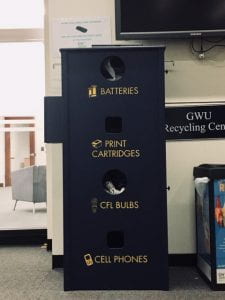With the climate crisis more pressing than ever, Bill Gates discussed his new book How to Avoid a Climate Disaster at a virtual webinar on February 17. CBS Correspondent Michelle Miller moderated the webinar, and attendees came from 4 D.C. based schools: The George Washington University, Georgetown University, American University and Howard University. One of the richest people in the world, Gates discussed his unique journey on how he became involved in the fight against climate change. Here are our main takeaways:
1. Innovations are key to reducing carbon emissions
At the event, GW Presidential Fellow Renea Williams got the once-in-a-lifetime opportunity to ask Gates what he believes are the most promising solutions that already exist to help combat climate change. While facing the challenge of avoiding a climate crisis can be daunting, Gates is optimistic because of his belief in innovation. From an early age, he’s always been obsessed with computers. Gates recalled when having a computer on every desk was a wild idea and now years later that idea is tame.
“My basic optimism about climate change comes from my belief in innovation. It’s our power to invent that makes me hopeful,” Gates said.
He emphasized that there needs to be investment in innovation that will have a lasting impact. Planting a tree is a positive investment, but it doesn’t compare to other gold standard offsets such as carbon capture models that pull carbon dioxide out of the atmosphere and sequester it for hundreds of thousands of years. The investment in innovations that have long term impacts are vital for a zero carbon emissions world.
2. Climate solutions must be rooted in environmental equity
In the discussion, Gates emphasized how climate solutions must take an equitable approach, grounded in the knowledge that climate change impacts poorer communities around the world in more devastating ways.
Climate mitigation strategies must “be intentional about the equity element of these efforts,” said Gates. “We've got to design that in from, from the very start.”
There should also be greater responsibility to reduce emissions for wealthier countries, who have historically contributed far more emissions than developing countries have. Gates highlighted the unfairness of the climate crisis, as poorer countries do not have as much technology and resources to build strong climate adaptation strategies. Ironically, these emissions were not even their fault to begin with, yet they are still paying the greatest price.
3. There needs to be a plan for climate change
Gates acknowledges that the young generation has taken a lead in accelerating the green movement. Across the globe, children have stepped out onto the global stage and demanding leaders commit to eliminating carbon emissions. While Gates praises the commitment of the younger generation, he also points out that there needs to be a plan.
“A plan that really admits that it's going to be very difficult. That looks at all the sources of emissions and taps into human ingenuity, taps into the private sector and government policy,” said Gates.
To effectively create a net zero emissions world by 2050, there needs to be a plan that details how to achieve that. The movement can garner all the momentum and support in the world, but without a plan it’s aimless. GW appears to be on the right track by committing to divest from fossil fuels by 2025, but the commitment can only be fulfilled with a clear and well-followed plan to do so.
4. When communicating climate change, focus less on the doom-and-gloom, and more on what’s worth saving
Regarding how to effectively communicate climate change, Gates recommended for young people to really tailor their message to who they’re speaking to. Many people have heard about the daunting consequences of climate change, but hearing these warnings often does not energize them to take action and only induces their anxieties more. Gates suggested that a more innovative approach could be to focus on the natural beauty of the planet and what’s worth saving. Fostering an appreciation for the planet helps drive others towards a call to action and fosters a deeper connection between the individual and the greater climate movement. In Gates’ opinion, one of the most effective examples of this storytelling approach is David Attenborough’s environmental documentary, A Life On Our Planet.
“You know we owe it in a moral way to not get rid of those beautiful natural ecosystems,” said Gates in reflection to the film.
If Bill Gates supports solutions-driven climate communication, then GW’s very own Planet Forward seems to be on the right track. Planet Forward is an environmental news site housed at GW’s School of Media and Public Affairs for students around the country to publish inspiring environmental stories. Over the years, SustainableGW and Planet Forward have fostered a tight relationship to train students on how to powerfully and effectively communicate the urgency of the climate crisis.

